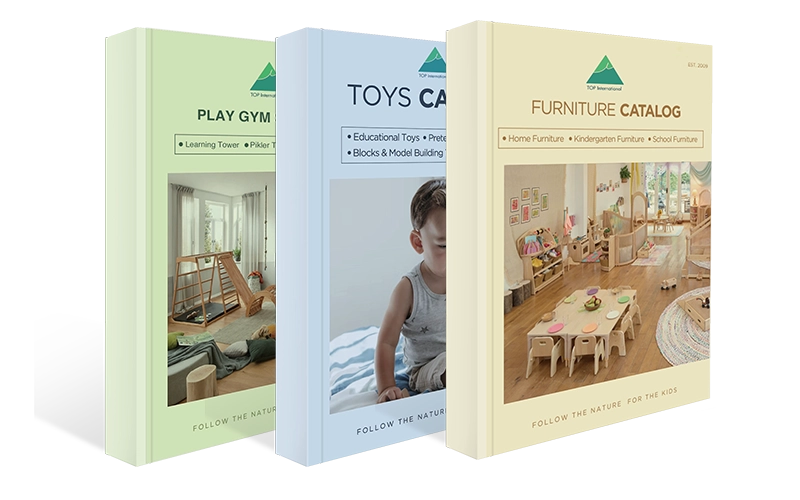Have you ever wondered why certain milestones are set for preschoolers? Why do children need structured learning goals at such a young age? Preschool learning objectives are pivotal in laying the foundation for children’s future success. From cognitive skills to emotional intelligence, these objectives are designed to help children explore the world around them while gaining critical skills that shape their lives.
Preschool learning objectives matter because they guide children’s early development in key areas such as cognitive, emotional, social, and physical growth. Setting clear goals ensures that children learn essential academic concepts like numbers and letters and develop key social and emotional skills that serve them well. Preschool learning objectives help create a well-rounded foundation for young learners, ensuring they are ready for the following stages of their education journey. These learning objectives provide clear direction for educators and parents, ensuring that young learners grow in a balanced, comprehensive manner.
Please keep reading to discover how these objectives impact preschoolers’ learning journeys and the essential milestones children should achieve during their early education.

What are learning objectives in early childhood education?
Preschool learning objectives are specific goals set by educators and caregivers to guide children’s development in their early years. These objectives focus on various aspects of growth, from intellectual skills like language and math to emotional and social development. Examples of preschool learning objectives might include building basic motor skills or developing early literacy.
Learning objectives for preschoolers help structure a child’s day and curriculum, allowing them to develop holistically. These objectives create a roadmap for early education that ensures children grow in multiple developmental areas, including their cognitive, social, emotional, and physical well-being.
1. Cognitive Development Objectives
Cognitive development refers to a child’s ability to think, understand, reason, and remember. Preschool is when children begin to form the foundational cognitive skills that will enable them to engage with the world in a more profound, more structured way. Some key learning objectives examples for preschool in this area include:
1.1 Developing Early Math Skills

One of the preschool math learning objectives is for children to start developing an understanding of basic math concepts such as numbers, counting, and shapes. Recognizing numbers, understanding their values, and learning to count are all essential milestones. Children will also begin to develop an understanding of spatial relationships through activities like matching and sorting shapes.
1.2 Building Early Literacy Skills
A key preschool learning objective is introducing children to letters, sounds, and words. They will learn to recognize the alphabet, understand the relationship between letters and their corresponding sounds, and begin to recognize simple words. This early exposure to language is vital for later reading and writing skills.

1.3 Problem-Solving and Critical Thinking

Encouraging problem-solving skills through hands-on activities is an essential objective in preschool. Activities like puzzles, games, and simple tasks that require critical thinking help children develop the skills to analyze situations, make decisions, and think creatively.
1.4 Understanding Cause and Effect
Preschoolers are naturally curious about the world around them, and a key preschool learning objectives is helping them understand cause and effect relationships. This can be taught through simple scientific experiments, observations, and daily routines.

2. Social-Emotional Development Objectives
Social-emotional development in preschool helps children understand their emotions, develop self-regulation, and learn how to interact with others positively. Some key learning objectives for preschool art and social-emotional development include:
2.1 Building Emotional Awareness

A core objective of preschool education is to help children identify and express their emotions. Activities like reading stories, talking about feelings, and using visual aids (like emotion cards) help preschoolers recognize emotions and develop appropriate responses.
2.2 Developing Social Skills
Preschool children learn to interact with others, share, take turns, and resolve conflicts. These social skills are vital for creating positive relationships with peers and adults. Teachers can support social development by creating structured play opportunities and guided group activities, encouraging teamwork and collaboration.

2.3 Building Self-Esteem and Confidence

Preschoolers need to develop a sense of self-worth and confidence in their abilities. Teachers can foster this by providing opportunities for children to succeed, offering praise and encouragement, and giving them choices that promote independence.
2.4 Understanding Empathy and Cooperation
Teaching preschoolers about empathy helps them develop the ability to recognize and respond to the feelings of others. By practicing sharing, helping others, and engaging in cooperative activities, children begin to understand the importance of working together and supporting their peers.

3. Physical Development Objectives
Physical development in preschool focuses on both fine and gross motor skills. These skills are crucial for daily tasks and overall health and well-being. The key preschool learning objectives examples in this area include:
3.1 Developing Fine Motor Skills
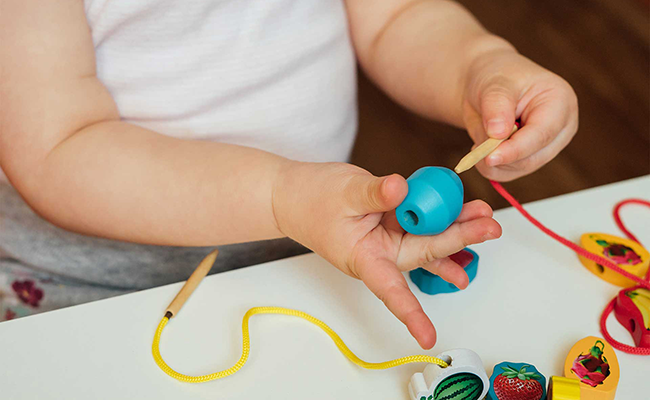
Fine motor skills involve the small muscles in the hands and fingers. Preschoolers work on activities like drawing, coloring, cutting with scissors, and manipulating small objects, all of which help to improve their hand-eye coordination and dexterity.
3.2 Enhancing Gross Motor Skills
Gross motor skills involve larger muscle groups used in activities like running, jumping, and climbing. Preschool children should be encouraged to engage in physical activities that promote balance, coordination, and strength, which are critical for later success in physical education and sports.

3.3 Promoting Healthy Habits

Preschool is an ideal time to teach children about the importance of good nutrition, hygiene, and physical activity. Simple lessons about washing hands, eating healthy foods, and engaging in physical play contribute to overall health and wellness.
4. Language and Communication Objectives
Language development is one of the most critical areas in preschool, as it forms the foundation for reading, writing, and effective communication throughout life. During preschool, children expand their vocabulary and develop listening, speaking, and writing skills crucial for their academic journey. The preschool learning objectives in this area aim to nurture a child’s ability to understand and use language meaningfully. Below are key objectives that target different aspects of language and communication development:
4.1 Building Vocabulary and Language Skills
At this stage, preschoolers are introduced to various words and concepts. The objective is to help children build a strong vocabulary to support their communication skills. Teachers and caregivers can use books, songs, and conversations to expose children to new words, helping them connect them with objects, actions, or feelings. This exposure allows children to understand and use language effectively in different contexts.

4.2 Developing Listening and Speaking Skills
Listening and speaking are foundational components of communication. Preschoolers should be encouraged to listen attentively to others and respond appropriately. Teachers can facilitate this development by creating activities that involve storytelling, group discussions, or simple question-and-answer sessions. These activities help children practice active listening, improve their ability to follow directions, and enhance their speaking skills by expressing their thoughts clearly and confidently.
4.3 Introduction to Writing
Although writing may begin at a basic level in preschool, it’s an essential skill that lays the groundwork for later literacy development. One of the key learning objectives for preschoolers in the language domain is to begin recognizing and writing letters. This involves drawing shapes, tracing lines, and writing their names. As they progress, children are introduced to writing simple words, which helps them connect spoken and written language.

4.4 Encouraging Storytelling and Narrative Skills
A significant language objective for preschoolers is to help them understand and retell stories. Whether through books or their own experiences, children are encouraged to express themselves through storytelling. This process boosts their language development and enhances their cognitive skills by helping them understand story structure, sequencing, and the concept of beginning, middle, and end.
4.5 Enhancing Social Communication
Language development is closely tied to social interaction. As preschoolers engage with peers and teachers, they learn to communicate effectively in social settings. They practice using polite expressions, taking turns in conversation, and asking questions. These skills are essential for establishing relationships and collaborating with others. The goal is to help children feel confident using language to express their needs, share ideas, and participate in group activities.

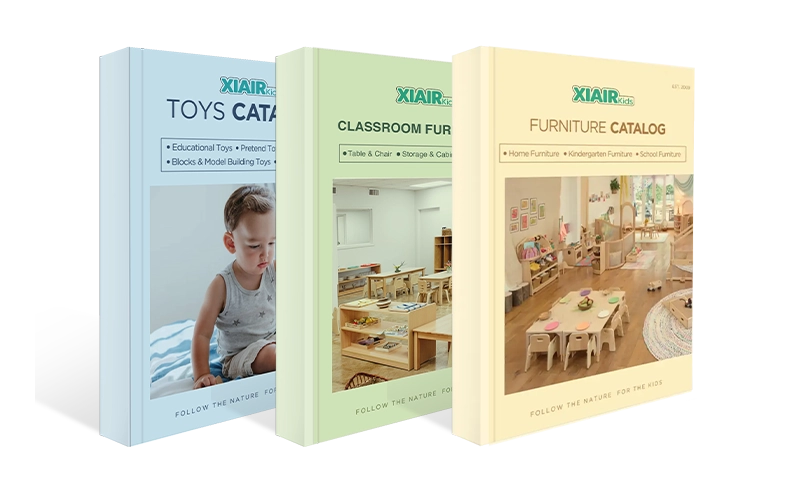
5. Creative development
Creative development is a core part of all preschool learning objectives. It fosters imagination, emotional expression, and problem-solving—key skills that support a child’s growth in every subject. Children build confidence and creativity through art, pretend play, and exploration.
5.1 Artistic Expression
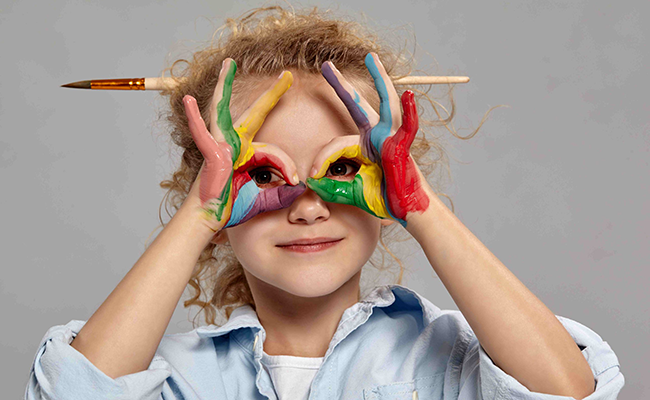
One of preschool art’s most common learning objectives is helping children express ideas through different materials. Painting, drawing, and sculpting teach more than just art—they develop fine motor skills and creativity. These are classic preschool learning objectives used in early education. In well-equipped classrooms, accessible art corners support these art learning objectives for preschoolers. Teachers enhance learning by encouraging children to talk about their work, building language and thinking skills.
5.2 Imaginative Play
Dramatic play meets many learning objectives for preschoolers—from language to social-emotional learning. Children pretending to be chefs, doctors, or shopkeepers explore roles and practice communication. High-quality classrooms include well-designed preschool centers for role play. These setups align with learning objectives for preschool centers and give kids the space to create, act out stories, and solve social challenges naturally.

5.3 Creative Problem-Solving

Problem-solving is a key part of creativity. Children learn to try, fail, and try again—building persistence. This supports vital preschool student learning objectives and helps children think outside the box. Teachers can support this with open-ended prompts like “What else can we try?” These moments reflect strong learning objectives for preschool teachers, encouraging critical thinking and independence.
5.4 Aesthetic Awareness
Children also develop an appreciation for beauty in colors, sounds, and shapes. This objective, often built into learning objectives for preschool art, helps children notice and enjoy the world around them. Beautiful, well-organized classrooms make a difference. Adding preschool learning center signs with objectives helps children understand what they’re learning and why, giving purpose to their play.

6. Early science concepts
Exploring science in preschool is all about curiosity. At this stage, children naturally ask “why” and “how”—those questions are where preschool learning objectives in science begin. Young children build the foundations of logical thinking and inquiry-based learning by observing, experimenting, and exploring.
6.1 Observing the World
One of the core learning objectives for preschoolers in science is helping children observe the world around them. Observing how plants grow, tracking weather changes, or noticing natural patterns teaches attention to detail. Teachers can set up preschool centers with natural materials—leaves, rocks, water—to support these goals. These are strong learning objectives for preschool centers, where children explore with all five senses.
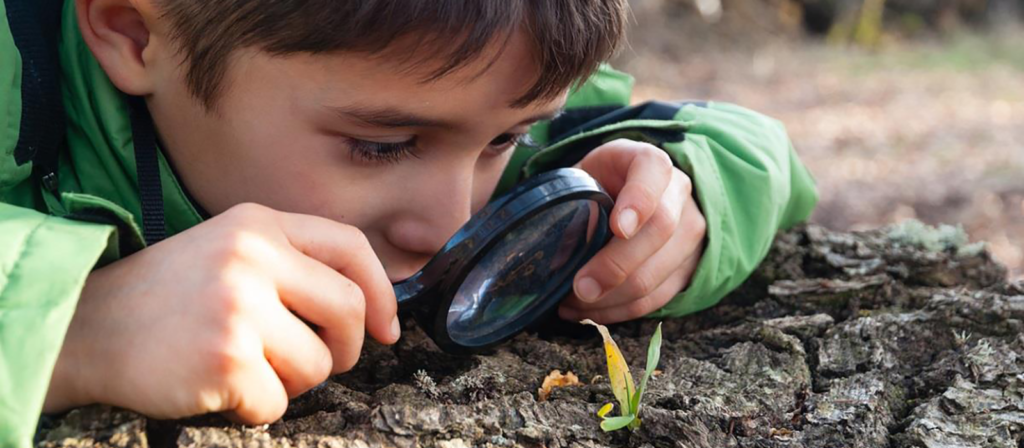
6.2 Asking Questions and Making Predictions
A big part of early science is wondering. “What happens if we mix these two colors?” or “Why did the ice melt?” These questions form the basis of preschool student learning objectives tied to critical thinking.
Children should be encouraged to ask, guess, and test their ideas. This process helps develop scientific thinking that aligns with learning objectives for preschool teachers responsible for creating inquiry-based activities.
6.3 Exploring Life and Physical Sciences
Children at this age also begin to understand basic science topics like animals, plants, and simple machines. These themes are part of structured learning objectives for preschool used in classrooms worldwide. Through classroom pets, nature walks, or hands-on experiments like planting seeds, children begin to connect with living things. These are classic learning objectives examples for preschool, helping kids understand how living systems work and how we care for the environment.
6.4 Recording and Reflecting
Preschoolers can draw pictures of what they observe, take photos, or even use simple charts to explore. These activities turn exploration into learning that sticks. This is essential to preschool learning objectives, especially as children transition into more structured learning. Learning objectives for preschool teachers often include helping students reflect on their learning. For instance, after a simple science experiment, a teacher might ask, “What did we learn?” or “What surprised you?”

7. Early literacy concepts
7.1 Letter Recognition and Phonemic Awareness
One of the first learning objectives for preschoolers is helping them recognize letters and their corresponding sounds. Phonemic awareness is essential for reading readiness. Children may start by identifying the first letter of their name, matching sounds to objects, or singing alphabet songs.
These are standard preschool learning objectives used worldwide. Children learn to associate symbols with sounds through songs, games, and hands-on materials like magnetic letters or alphabet puzzles, laying the foundation for decoding words.
7.2 Vocabulary and Language Growth
A significant goal in preschool learning objectives is vocabulary expansion. The more words children know, the more effectively they can express themselves and understand others.
Children learn new words and phrases through reading aloud, storytelling, and conversations. These vocabulary-rich interactions are key preschool student learning objectives, helping children describe their world and understand more complex ideas.

7.3 Book Awareness and Print Concepts
Another essential goal is teaching children how books work—knowing that we read left to right, that stories have a beginning and end, and that print has meaning. These concepts are simple but powerful learning objectives examples for preschool that create early reading habits.
Classrooms should have cozy reading corners and rotating book displays. Using preschool learning center signs with objectives, you can guide children and teachers to focus on specific literacy goals, like “Here we read books and talk about stories.”
7.4 Early Writing Exploration
Even before they can spell, children can write. One of the foundational preschool learning objectives in literacy is encouraging early writing behaviors, like scribbling, drawing, name writing, and eventually labeling pictures.
Children might start by tracing lines, drawing shapes, or attempting to write their names. These tasks develop hand strength and fine motor skills while reinforcing sound-letter connections. These are classic learning objectives for preschool art and literacy, which work hand in hand.

8. Early math concepts
Preschool learning objectives in math help children see that math is all around them. At this age, it’s not about memorizing numbers but about building a deep understanding of patterns, quantities, and relationships through hands-on activities. Solid learning objectives for preschoolers in math lay the groundwork for critical thinking, logic, and problem-solving.
8.1 Counting and Number Recognition
One of the most fundamental preschool math learning objectives is helping children recognize numbers and count objects accurately. This can begin with counting toys during cleanup or singing number songs—simple, everyday routines tied to meaningful learning. In a well-planned classroom, preschool centers can include math zones with counting beads, number puzzles, and sorting games. These areas meet targeted learning objectives for preschool centers, helping children connect symbols (like the numeral “3”) with real-world quantities.

8.2 Understanding Shapes and Spatial Awareness
Children are naturally drawn to shapes, colors, and structures. Recognizing and naming shapes is another key part of preschool learning objectives in early math. Children learn to identify circles, squares, triangles, and more—and to use them in building and play. Teachers help by using rich language: “You put the triangle on top of the square!” or “What happens if we flip it this way?” These guided discussions reflect core learning objectives for preschool teachers, which emphasize building vocabulary alongside math skills.
8.3 Sorting, Patterns, and Classification
Sorting objects by color, size, or shape helps children understand patterns and relationships—key foundations for future algebraic thinking. This is why pattern recognition is a staple in preschool learning objectives. In math-focused learning areas, tools like pattern blocks, colored counters, and simple charts help children work independently or in small groups. These setups align closely with best practices for preschool centers’ learning objectives, especially in Reggio or Montessori-inspired environments.

9. Personal care and hygiene
Developing independence is a key part of preschool learning objectives. In particular, personal care and hygiene help children gain confidence, build responsibility, and support their physical well-being. These skills are life essentials, and starting them early means children are better prepared for school and home routines.
9.1 Learning Self-Care Routines
One of preschoolers’ most important learning objectives is knowing how to care for their basic needs. This includes:
- Washing hands correctly
- Wiping their nose
- Brushing teeth
- Using the toilet independently
These goals are foundational preschool student learning objectives and help children develop autonomy. When children learn to care for themselves, they also feel more in control of their day—a key factor in emotional security.
Teachers play a critical role here. They support these everyday tasks with routines, visuals, and consistent encouragement. This ties directly to essential learning objectives for preschool teachers, which include modeling and guiding hygiene routines in age-appropriate ways.
9.2 Clean-Up and Responsibility
Preschoolers also learn to take care of their environment. One classic learning objective is teaching children how to clean up after themselves—putting away toys, throwing away tissues, or wiping up a spill. These actions may seem small but build responsibility and care for shared spaces. In classrooms with preschool learning center signs with objectives, a cleaning station with a sign like “Here we take care of our classroom” can reinforce the goal clearly and consistently. Through consistent daily routines, children naturally meet these preschool learning objectives examples, developing habits they’ll use for life.
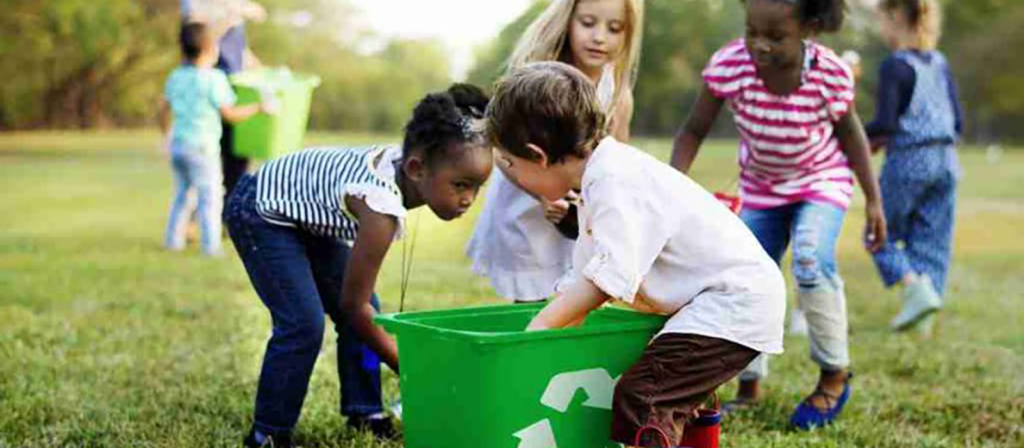
9.3 Understanding Health and Safety
Another key part of preschool learning goals and objectives is helping children understand why hygiene matters. It’s not just about routine—it’s about staying healthy and respecting others. Teachers explain germs in simple terms, show why tissues and handwashing are essential, and guide children through seasonal health routines.
This connects directly to learning objectives for preschool centers focused on safety and health education. For example, during flu season, children may learn songs about handwashing or role-play “going to the doctor” in dramatic play areas. These activities are not only fun, but they also align perfectly with social-emotional and health-related learning goals.
9.4 Dressing and Daily Independence
Dressing themselves is another big win for preschoolers, from zipping coats to changing shoes. These moments are practical, achievable milestones under preschool learning objectives. With child-sized furniture, coat hooks, and cubbies, children gain confidence by managing their belongings and preparing for transitions. Teachers support this process by allowing time and space for self-dressing, encouraging persistence, and praising small successes. These supportive strategies reflect practical learning objectives for preschool teachers, who aim to create independent, self-sufficient learners.

10. Listening skills
Strong listening skills are essential to early learning. They impact how children follow directions, participate in group activities, and understand language. That’s why well-designed preschool learning objectives include focused goals around listening, attention, and verbal comprehension. Many learning objectives for preschoolers start with learning to listen, before reading, writing, or speaking fluently.
10.1 Following Directions

Preschoolers first develop listening by learning to follow simple instructions. Teachers give short, clear directions like “Put the blocks away” or “Line up by the door.” Over time, they build toward two- and three-step directions. This skill is part of everyday life and supports many preschool learning objectives. Whether it’s following a recipe in a sensory activity or instructions during cleanup, children learn to process what they hear and act accordingly.
10.2 Participating in Group Time
Circle time, story sessions, and music time shine when listening skills shine. Children learn to sit, focus, take turns talking, and respond to prompts. These goals support both communication and behavior management in the classroom. Listening in a group builds focus and respect for others, core preschool student learning objectives tied to both social and language development. Well-structured classrooms include carpet areas or quiet zones for group time.

10.3 Practicing Turn-Taking and Active Listening
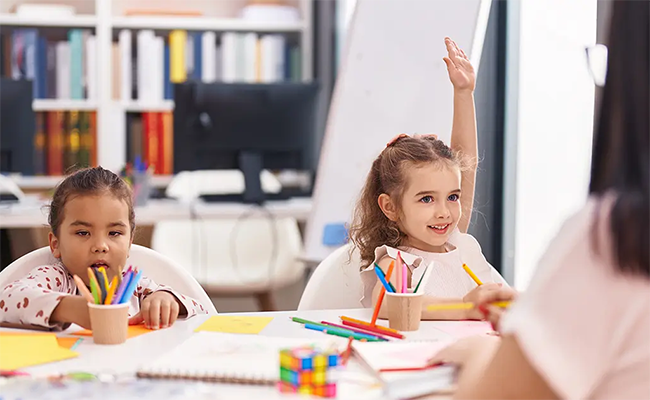
In conversations, children learn to listen, respond, and understand. Practicing turn-taking is a key social behavior embedded in many learning objectives for preschoolers. Activities like show-and-tell, partner interviews, and role-play help children develop this skill. Teachers model good listening—maintaining eye contact, nodding, and responding thoughtfully—behaviors that children begin to copy. These small group and peer activities support multiple preschool learning objectives, including language, social-emotional development, and classroom participation.
How Do Educators Achieve Preschool Learning Objectives?
Achieving preschool learning objectives requires effective teaching strategies catering to young children’s developmental needs. Since preschoolers learn best through play, hands-on activities, and social interactions, educators use diverse methods to make learning engaging and fun while ensuring that key educational goals are met. Below are some of the approaches educators employ to help preschoolers reach their learning objectives:
Play-Based Learning
One of the most powerful teaching methods in preschool education is play-based learning. Children naturally explore and learn new concepts through play and develop critical thinking skills. Activities like role-playing, building with blocks, or even playing pretend games allow children to make sense of the world around them. This form of learning is particularly effective for fostering both cognitive development and social-emotional growth as it encourages children to think creatively, solve problems, and interact with their peers. Educators ensure children develop essential skills such as language, motor coordination, and teamwork by integrating preschool learning objectives into play.
Hands-On Activities
Hands-on activities are key to keeping preschoolers engaged and helping them understand abstract concepts concretely. Activities such as sorting shapes, counting objects, or experimenting with sensory bins help children apply new knowledge in real-world contexts. Preschool math learning objectives, for example, are achieved through counting games or sorting activities that allow children to interact physically with numbers and shapes. These tactile experiences solidify their understanding and give them a more profound, practical knowledge of basic concepts.

Collaborative Learning
In a preschool setting, collaboration is crucial in developing learning objectives for preschoolers. Group activities, cooperative games, and team projects help children develop essential social skills like communication, cooperation, and empathy. Whether working together on a puzzle, building a structure, or engaging in a group discussion, children learn how to navigate social interactions, share ideas, and respect others’ opinions. These preschool learning objectives related to social-emotional development are achieved through consistent opportunities for group work, which promote a sense of community and help children build strong interpersonal skills.

Thematic or Center-Based Learning
Another effective method for achieving preschool learning objectives is thematic learning or learning centers. Different classroom areas are dedicated to specific subjects or activities in these settings, such as a reading corner, an art station, or a science exploration table. These “centers” allow children to explore various themes and skills hands-on and self-guided. For example, in a preschool learning center, children might engage in art activities to meet art learning objectives for preschoolers or participate in building projects to achieve preschool math learning objectives. By rotating through these centers, children are exposed to various learning opportunities that align with the curriculum’s goals and objectives.

Technology Integration
While the foundation of preschool education remains in hands-on, interactive learning, integrating age-appropriate technology into the classroom can effectively support preschool learning objectives. Interactive apps, educational games, and videos can complement traditional teaching methods, helping children grasp new concepts and skills. For example, using an interactive app to practice letter recognition or counting can reinforce preschool learning objectives dynamically and engagingly. However, technology must be used thoughtfully, ensuring it enhances, rather than replaces, the essential face-to-face social and physical activities preschoolers need.
Continuous Observation and Assessment
Educators rely on ongoing observation and assessment to achieve learning objectives for preschool centers. By continuously monitoring how children interact with various activities, educators can tailor their teaching strategies to meet individual needs. These assessments help determine whether children are achieving the goals outlined in their preschool student learning objectives or whether additional support is required. Through informal assessments like observations, discussions, and child-led activities, educators can adjust their approach to ensure every child is progressing toward the set learning objectives.
Incorporating these diverse and flexible teaching strategies ensures that preschool learning objectives are met in a way that nurtures the whole child. By focusing on the developmental needs of young learners and providing them with engaging, interactive learning opportunities, educators create a solid foundation for future academic and personal growth.

Why Preschool Learning Objectives Matter?
Preschool is a critical time for children, serving as the foundation for their future academic and personal growth. During these early years, children develop essential skills that will serve them. This is where preschool learning objectives come into play. These objectives are not arbitrary but are carefully crafted to support a child’s development in multiple domains, including cognitive, emotional, social, and physical growth. They create a structured and purposeful learning environment that ensures each child reaches their full potential, engagingly and educationally.
Preschool learning objectives are designed to guide educators, caregivers, and parents in creating a supportive learning environment that nurtures a child’s curiosity, intellect, and emotional well-being. These goals are pivotal for academic success and fostering critical life skills like problem-solving, emotional regulation, and effective communication. Without clear learning objectives, it becomes challenging to measure a child’s growth or identify areas where further support might be needed.
Providing Direction for Development
One of the primary reasons preschool learning objectives matter is that they provide direction for a child’s developmental journey. Children are like sponges at this age—ready to absorb information, explore new ideas, and learn about the world around them. However, without a structured approach, it can be easy for children to become overwhelmed or distracted. Clear learning objectives ensure that each child has a focused and intentional path toward growth.
For example, learning objectives for preschoolers may include mastering basic numeracy, recognizing shapes and colors, or learning to count to 10. These objectives provide the teacher and the child with specific goals to work towards. This clear direction ensures that children aren’t simply playing for the sake of playing but are engaging in activities that foster their cognitive and developmental progress.
Laying the Foundation for Future Learning
The early years of education are critical because they lay the foundation for later learning. Preschool learning objectives help ensure that children develop essential skills that will be built upon in subsequent years. Without mastering the fundamentals, it would be difficult for children to keep up with academic demands in kindergarten and beyond.
For instance, preschool math learning objectives such as recognizing numbers, understanding basic arithmetic concepts, or learning to identify shapes and patterns are essential stepping stones for later learning. Similarly, early literacy skills like recognizing letters, understanding phonetic sounds, and developing vocabulary are crucial for reading and writing. By setting clear learning objectives in these areas, preschool educators ensure children have the tools to succeed in more complex subjects as they move through their educational journey.
Promoting Emotional and Social Development
While academic skills are essential, preschool is also when children develop crucial emotional and social skills. Preschool learning objectives are not limited to cognitive and academic growth—they also address a child’s emotional well-being and social interactions with others. For example, learning objectives for preschool centers may focus on teaching children how to share, take turns, express emotions appropriately, and resolve conflicts. These social-emotional skills are vital because they form the foundation for positive interactions throughout a child’s life.
Incorporating emotional development into preschool learning objectives helps children develop empathy, self-awareness, and emotional regulation. These skills are essential for personal growth and contribute to a child’s ability to work in groups, build relationships, and thrive in a classroom setting. Children who learn to manage their emotions and work well with others are better equipped to succeed in school and social life.

Building Confidence and Independence
When children meet the preschool learning objectives set for them, it boosts their confidence and sense of accomplishment. Children are beginning to understand their abilities and limitations at this early stage. Achieving small goals, such as recognizing a letter or completing a puzzle, reinforces their self-worth and encourages a positive attitude toward learning. Preschool learning goals and objectives provide the structure and support children need to develop this sense of self-efficacy.
In addition, clear learning objectives help children develop independence. As they master new skills and concepts, children feel empowered to take on more challenges independently. Whether it’s choosing a book to read, solving a simple puzzle, or expressing their feelings in a group setting, the ability to tackle tasks independently builds confidence. It encourages children to take the initiative in their learning.
Creating a Structured Environment
Preschool learning objectives also help create a structured and predictable environment for children. Children thrive when they know what to expect and clearly understand routines. Learning objectives guide educators and children by setting clear daily goals and expectations. For instance, a preschool learning center might focus on a particular theme or activity each week, allowing children to delve deeper into subjects like numbers, animals, or colors. This structure helps children focus on the task and ensures that learning remains consistent and organized.
A structured environment also fosters a sense of security for children. Children are more likely to feel comfortable and confident when they know what to expect from their day: circle time, art activities, or playtime. This stability allows children to engage more deeply in learning and helps them thrive emotionally and socially.
Measuring Progress and Identifying Areas for Improvement
Another significant reason preschool learning objectives matter is that they help educators and parents track a child’s progress. Setting clear goals makes it easier to identify areas where a child excels and where they may need additional support. For example, if a preschooler struggles to recognize letters or numbers, educators can adjust their teaching strategies or provide extra practice to help the child catch up.
Regular assessments tied to preschool learning objectives ensure that children are not left behind and their needs are addressed. These assessments can be formal or informal, from observing how children interact with learning materials to providing one-on-one support in specific skill areas. By tracking progress, educators can tailor their approach to meet the needs of each child, ensuring that all students are allowed to thrive.
Encouraging a Lifelong Love of Learning
Ultimately, one of the most essential reasons preschool learning objectives matter is that they help instill a love of learning in children. When children are engaged in meaningful activities that are aligned with their developmental needs, they begin to associate learning with positive experiences. By making learning fun and interactive through games, art, music, and exploration, educators help children develop curiosity and excitement for the world around them.
These early experiences set the tone for how children approach learning. Children who enjoy learning in their early years are likelier to remain curious, motivated, and engaged in education as they grow older. Setting clear learning objectives and helping children achieve them prepares them for the academic challenges ahead and fosters a positive attitude toward learning that lasts a lifetime.

Ages 2-4 vs Ages 3-6: A Comparison
| Learning Area | Ages 2-4 | Ages 3-6 |
|---|---|---|
| Cognitive Development | Focus on exploring basic concepts such as colors, shapes, and sizes. Learning objectives for preschoolers at this stage include identifying objects, recognizing simple patterns, and engaging in problem-solving activities. | In this age group, cognitive development deepens, as children begin learning more complex ideas such as basic math, letter recognition, and sequencing. Key preschool learning objectives at this stage include mastering counting and beginning to understand letter-sound relationships. |
| Language Skills | Children’s vocabulary grows significantly between the ages of 3 and 6. Preschooler learning objectives now include sentence structure, storytelling, and understanding the concepts of past, present, and future. | By ages 3-6, children’s vocabulary grows significantly. Learning objectives for preschoolers now include sentence structure, storytelling, and understanding the concepts of past, present, and future. |
| Social and Emotional Development | Preschoolers aged 2-4 begin understanding their emotions and interacting more with their peers. Learning objectives for preschool centers include recognizing feelings, practicing sharing, and managing conflicts with guidance. | At ages 3-6, children start showing empathy, can regulate their emotions, and understand more complex social cues. They also begin to cooperate in group settings. Preschool student learning objectives at this age focus on teamwork, empathy, and forming lasting friendships. |
| Physical Development | Learning objectives for preschool during ages 2-4 include fine and gross motor skills such as walking, climbing, stacking blocks, and improving hand-eye coordination. | Between the ages of 3 and 6, children improve their motor skills further, learning to write, cut with scissors, and engage in more complex physical activities. Preschool learning goals and objectives at this stage focus on balance, coordination, and further refinement of fine motor control. |
FAQs
1. How can parents support preschool learning objectives?
Parents can support preschool learning objectives by engaging their children in activities that reinforce key skills at home. This can include reading together, practicing basic math, playing social games, and encouraging physical activities.
2. How are preschool learning objectives assessed?
Preschool learning objectives are assessed through formal and informal methods, including observations, child-led activities, and one-on-one support. These assessments help track a child’s progress and ensure they meet their developmental milestones.
3. Are preschool learning objectives the same for all children?
While the general goals are similar, preschool learning objectives can be adjusted to accommodate each child’s unique needs and developmental pace. Personalizing learning helps ensure that every child meets their milestones.
4. How do preschool learning objectives benefit social development?
Preschool learning objectives play a crucial role in fostering social development. By focusing on goals such as sharing, taking turns, and working in groups, children learn essential social skills that help them interact effectively with their peers.
5. Can preschool learning objectives be adjusted based on individual needs?
Yes, preschool learning objectives are often adjusted to accommodate each child’s unique developmental pace and needs. Teachers observe individual children’s progress and tailor their goals to ensure every child receives the support they need.
6. What are the long-term effects of achieving preschool learning objectives?
Achieving preschool learning objectives has long-lasting effects on a child’s academic and personal growth. Children who meet early learning goals tend to have better academic performance in later years as they develop strong foundational skills in literacy, numeracy, and emotional regulation.
Conclusion
Preschool learning objectives provide a framework that supports young children’s cognitive, emotional, and physical development. By setting these objectives, educators and caregivers create a learning environment where children can thrive and prepare for the challenges ahead in their academic careers. These objectives guide preschool learning goals and promote a well-rounded foundation that helps children become confident, curious, and capable learners.
When these objectives are met, children enter kindergarten and beyond with the necessary skills and a strong foundation for lifelong learning. The early years of education are crucial, and achieving these goals sets the stage for continued success throughout the child’s educational journey.








